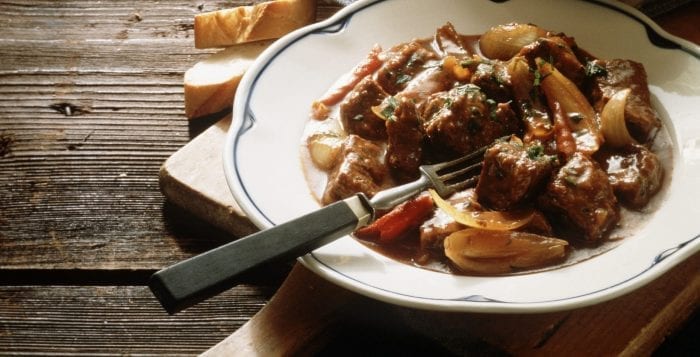By Barbara Beltrami
I’m sitting here listening to the rain pelt the windows while the wind howls, and all I can think of besides lighting a fire and curling up in front of it is to stand in my fuzzy slippers at the kitchen counter and chop veggies and meat into chunks for a hearty stew. I’m going to go to my recipe files, find something that doesn’t require any ingredients I have to go out in the rain and wind to buy (and if it does, I’ll tweak it to accommodate what I have on hand). I’ll put a big pot on to simmer, then I think I’ll light that fire and curl up in front of it while the savory aromas of the stew waft through the house.
Beef Stew with Root Veggies
YIELD: Makes 8 servings.
INGREDIENTS:
½ cup flour
Salt and freshly ground black pepper to taste
4 pounds stewing beef, cut into 2-inch cubes
½ cup olive oil
1 large onion, chopped
2 cups dry white wine
1 quart beef broth
2 tablespoons chopped fresh thyme
1 pound carrots, peeled and cut into 2 -inch pieces
1 pound parsnips, peeled and cut into 2-inch pieces
½ pound turnips, peeled and cut into 2-inch pieces
1 large fennel bulb, trimmed and cut into 2-inch pieces
1 pound baby potatoes, scrubbed
1 pound pearl onions, peeled
3 tablespoons minced flat-leaf parsley
DIRECTIONS:
Preheat oven to 350 F. In a large bowl combine flour, salt and pepper. Add beef cubes in small batches and toss to coat thoroughly. In large Dutch oven or heavy casserole, heat two tablespoons oil. Add flour-coated meat in four batches, adding two more tablespoons oil with each batch, and over medium-high heat, brown it on all sides, about 6 minutes; transfer to bowl to keep warm. Add chopped onion, and stirring frequently, cook until soft and transparent, about 3 minutes. Add white wine, broth and thyme; bring to boil; return beef to pot; cover and braise in oven for one hour. Add veggies, potatoes, onions and parsley and cook for another hour, until veggies are tender; add more salt and pepper to taste. Serve hot with a crisp salad and warm crusty French bread.
Chicken Stew with Green Chilies
YIELD: Makes 6 servings.
INGREDIENTS:
½ cup olive oil
2 pounds skinless boneless chicken thighs cut into 2-inch pieces
1 large onion, chopped
1 pound poblano or Anaheim chilies, halved lengthwise, cored and thinly sliced
3 serrano chilies thinly sliced
4 large garlic cloves, thinly sliced
2 cups chicken broth
Salt and freshly ground pepper to taste
¼ cup chopped cilantro
6 lime wedges
DIRECTIONS:
In large heavy casserole or Dutch oven heat oil until very hot. Season chicken with salt and pepper, then add it to oil and cook, turning at least once, over high heat, until lightly browned, about 5 minutes. Add onion, both kinds of chilies and garlic. Season again with salt and pepper. Cover and cook over medium high heat until chiles are softened, about 5 minutes. Add chicken broth and bring to a boil. Cover partially and simmer until everything is tender and liquid is reduced by half. about 15 minutes. Stir in cilantro, garnish with lime wedges and serve immediately with taco chips and rice
Lamb and Chick Pea Tagine
YIELD: Makes 8 servings.
INGREDIENTS:
¼ cup olive oil
4 garlic cloves, minced
Peeled (not grated) zest from half a lemon
2 teaspoons ground ginger
2 teaspoons ground coriander
1 teaspoon ground cumin
Salt and freshly ground black pepper to taste
½ teaspoon dried red pepper flakes
Pinch crumbled saffron threads
1 cinnamon stick
3½ pounds boneless lamb shoulder, cut into 2-inch pieces
4 cups water
8 carrots, peeled and cut into ¼-inch slices
1 onion, diced
2 cups pitted green olives
One 14-ounce can chick peas, rinsed and drained
1 cup flat-leaf parsley, chopped
1 cup cilantro leaves, chopped
2 to 3 tablespoons freshly squeezed lemon juice
DIRECTIONS:
In large bowl, mix together oil, garlic, lemon zest, ginger, coriander, cumin, salt and pepper, dried pepper flakes, saffron and cinnamon and lamb. Cover and refrigerate 6 to 8 hours. Transfer to a tagine or heavy Dutch oven. Add water, carrots and onion; bring to simmer, cover and cook over low heat until lamb is very tender, about two hours. Skim any fat from broth, add olives and chick peas and cook another two or three minutes. Remove from heat, stir in parsley, cilantro and lemon juice. Serve immediately with couscous and a cucumber salad.



















